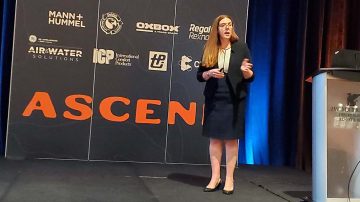Woodcliff Lake, NJ – March 27, 2023 – As the HVACR industry adjusts to a dramatic cut in the amount of HFCs available for new refrigerants, Kate Houghton is busy preaching the gospel of reclamation. Her message is simple: As HFCs become scarcer, due to the mandates of the federal AIM Act and the Environmental Protection Agency (EPA) phasedown plan, the market for high-GWP HFC refrigerants like R-410A continues to grow, and large quantities of those refrigerants will be needed for existing systems for the next couple of decades. Therefore, refrigerant recovery and reclamation are increasingly valuable and, indeed, essential for those who plan to continue servicing those systems.
“If you look at what the future looks like, in all aspects we’re tightening the supply of virgin HFCs” because of the phasedown as well as a growing equipment base, Houghton recently told a group of HVACR distributors. “The only way that we close that gap is growing reclamation and having that supportive system as we move forward.”
The production and importation of HFCs, chemicals that contribute to global warming, is regulated by the EPA. The EPA’s phasedown began in 2023, when the supply of HFCs was cut by 10% from an established baseline. Starting this year, the supply drops by another 30%; the EPA’s plan will reduce HFC availability to just 15% of the baseline by 2036. Meanwhile, residential HVAC equipment that requires higher-HFC refrigerants, like R-410A, can be manufactured through this year, and sold through 2025.
“We continue to be able to make OEM equipment and install equipment,” Houghton said. “And we continue to grow demand for those HFC refrigerants while we’re reducing the availability of the refrigerant itself.”
Houghton pointed out that HFCs are used not just in heating and cooling, but also in processes like foam-blowing and fire suppression. With reduced HFC availability, she said, companies in several industries are deciding how to best use their allocations, and HVACR is in competition with other industries.The good news, Houghton said, is that recovered refrigerant has value and that refining it and reusing it will support millions of HVAC systems and build a circular and more sustainable economy for it. The recent story of the refrigerant R-22, Houghton said, is a model for what should happen with high-HFC refrigerants. New R-22 has not been legally available since the end of 2019, she said, but millions of systems that use it are still in operation.
“The way that those R-22 systems are maintained today is through reclaimed refrigerant … and keeping that reclaimed refrigerant circulating in the marketplace,” Houghton said.
Houghton defined what she called the three Rs: recovery, recycling, and reclamation. Recovered refrigerant, she said, is refrigerant that’s been taken out of a system and not refined in any way. It can only be used by its owner, she said; a supermarket chain, for example, can send it to another store in the same company, but can’t sell it to another company. Recycled refrigerant, she said, is recovered refrigerant that’s been minimally processed — perhaps some moisture and particulate matter have been taken out — and still can be used only by its owner. Reclaimed refrigerant, she said, has been processed, by an EPA-certified reclaimer, back to the AHRI 700 standard, and can be returned to the marketplace.
“It’s putting money back into the channel and bringing the economic value for that recovered refrigerant,” Houghton said. “And so we’re looking to grow reclamation and we’re looking to grow recovery and we’re looking to grow the overall availability of reclaimed refrigerant.”
Refrigerants, she said, can be recovered and reclaimed over and over again, and don’t go bad. “We’ve probably seen the same pounds of CFCs come through our facility 20 times,” she said. CFC refrigerants, which have high ozone-depletion potential, were phased out in the U.S. years ago. Houghton also addressed what she said are some myths about refrigerant reclamation. Among them:
- That the average residential refrigerant recovery takes 30 minutes to an hour. Houghton said Hudson hears this from contractors. With the right equipment and setup, she said, it’s more like 15 to 20 minutes. “Helping contractors understand how we can improve and reduce recovery time is an important element in increasing the amount of reclaimed and recovered refrigerant,” she said.
- That there’s a shortage of refrigerant cylinders used for recovery. While there was a cylinder shortage, due to supply-chain issues that stemmed from the coronavirus pandemic, two or three years ago, that is no longer the case, Houghton said. “They’re generally widely available,” she said.
- That contractors get charged for turning in mixed refrigerant for reclamation.
- That was common, Houghton said, prior to the AIM Act, when the value of HFCs was lower, but the market conditions have changed, and recovered mixed HFC refrigerants have value, along with recovered CFCs and R-22. It’s important, she added, that the industry increases awareness of that fact among HVACR contractors.
“If we do not grow recovered refrigerant, and we do not grow reclamation, that contractor who today doesn’t want to bring you mixed refrigerant because they think they’re going to be charged may not be able to buy that R-410A to service that system, that he just sold, in three years’ time,” she said.
To read more, log into your ACHR News account, here.



